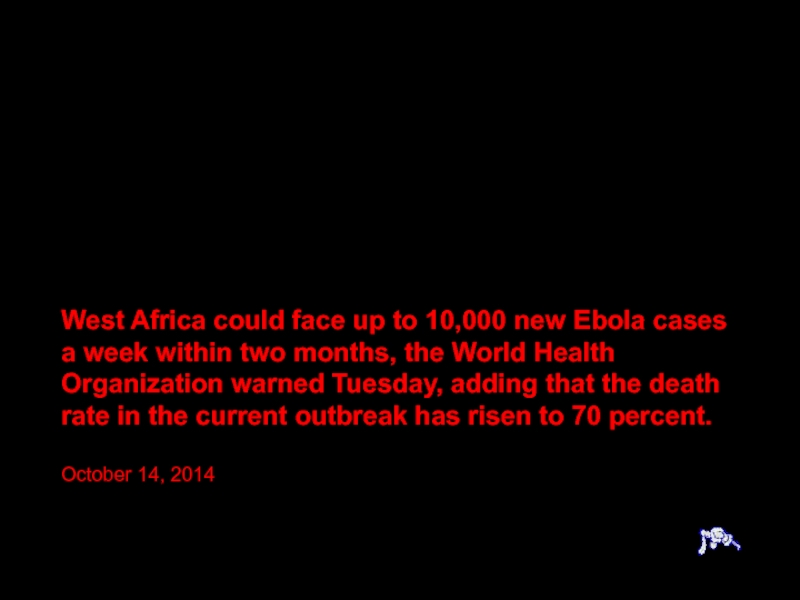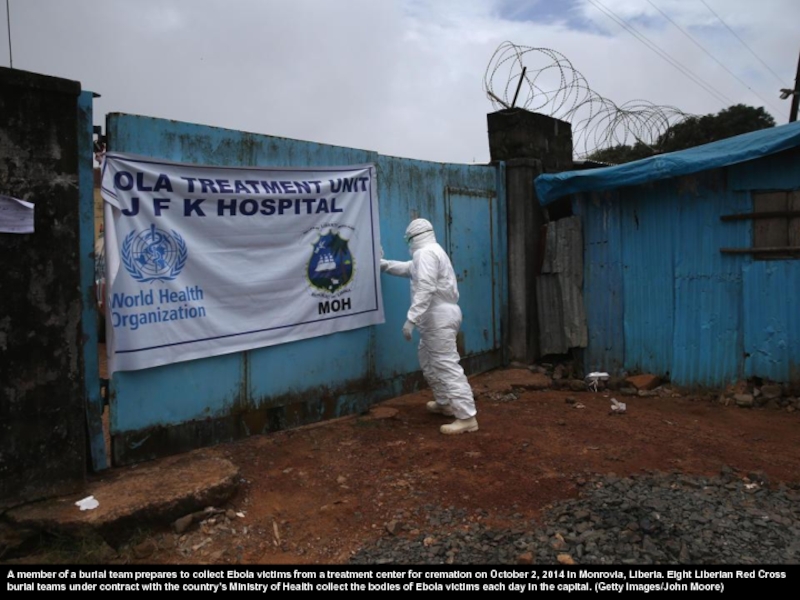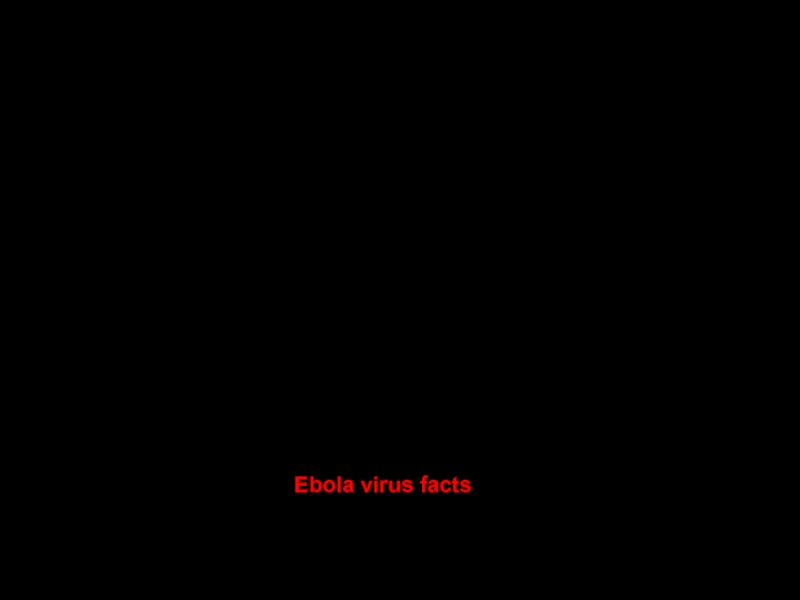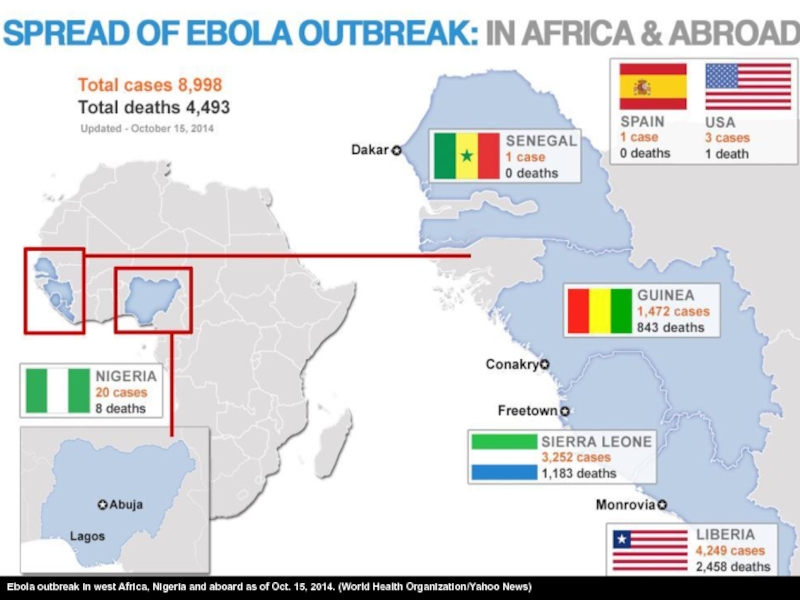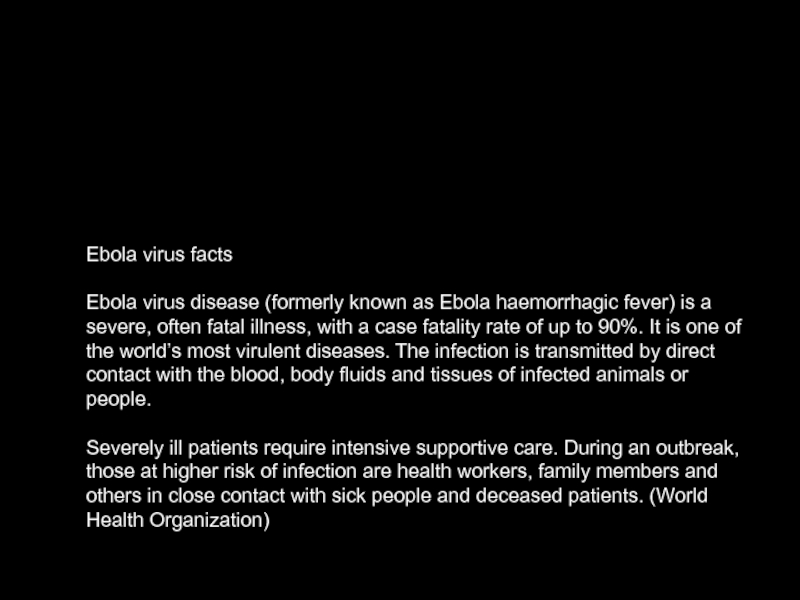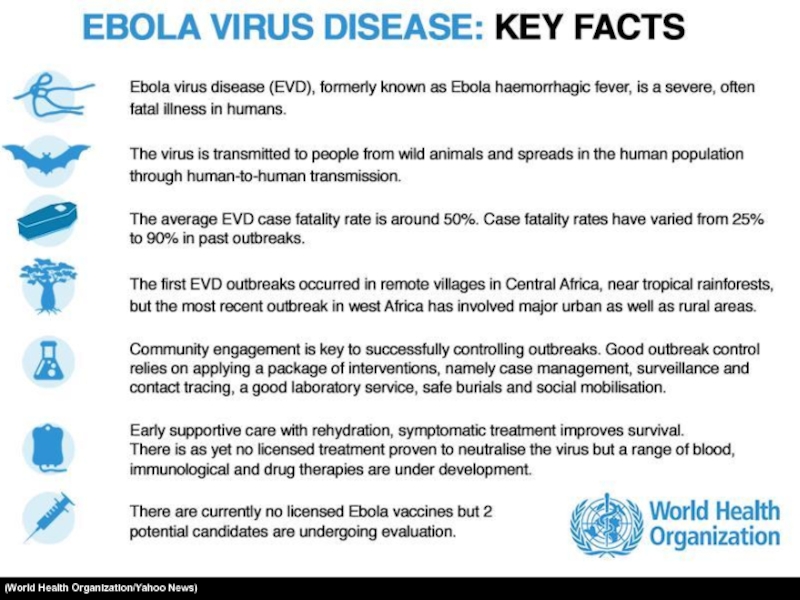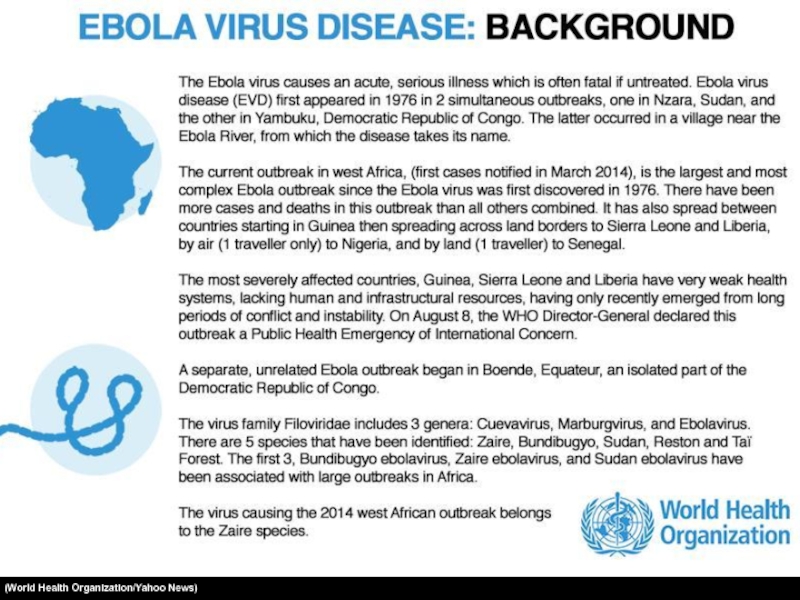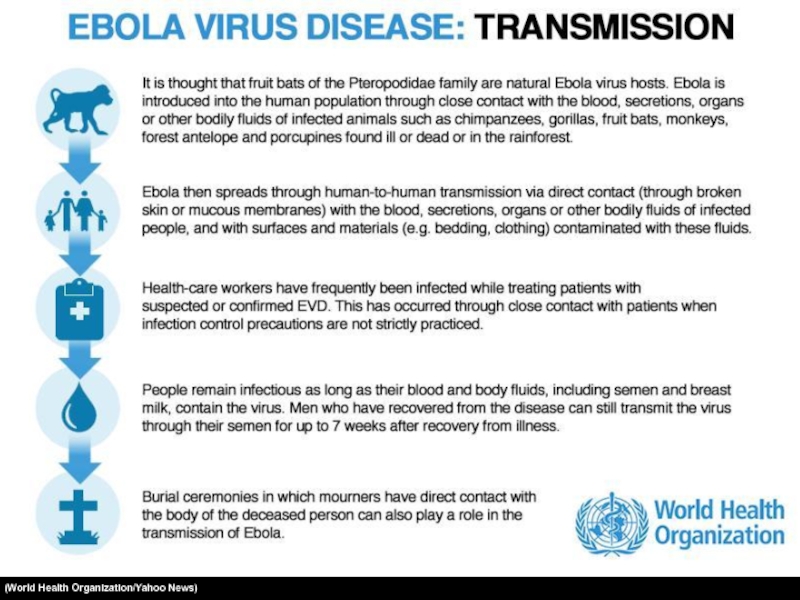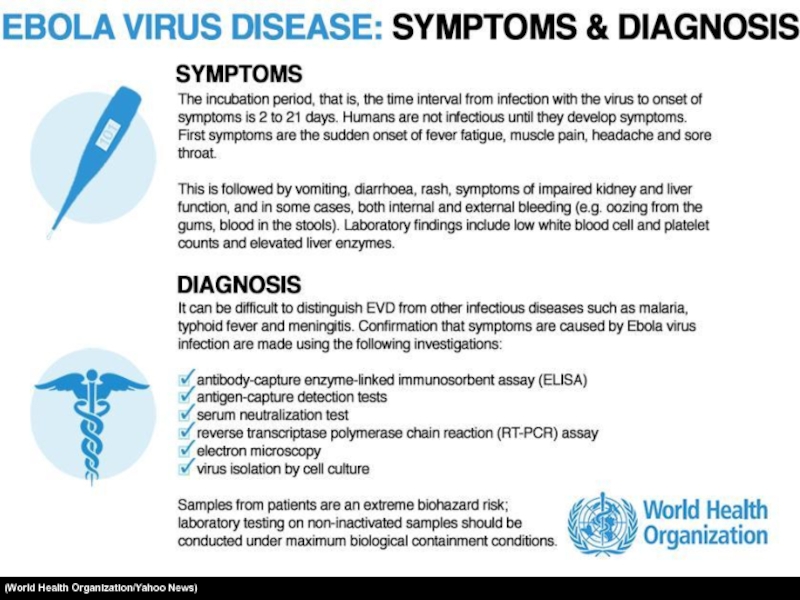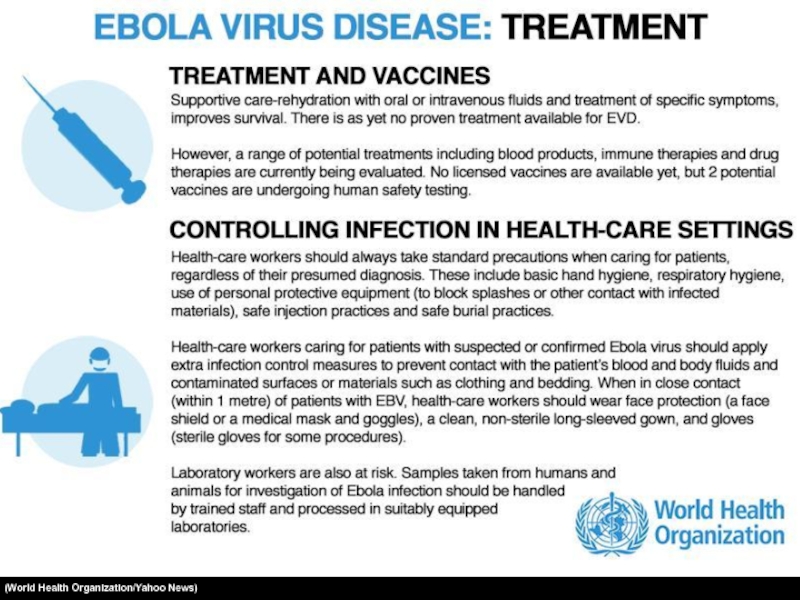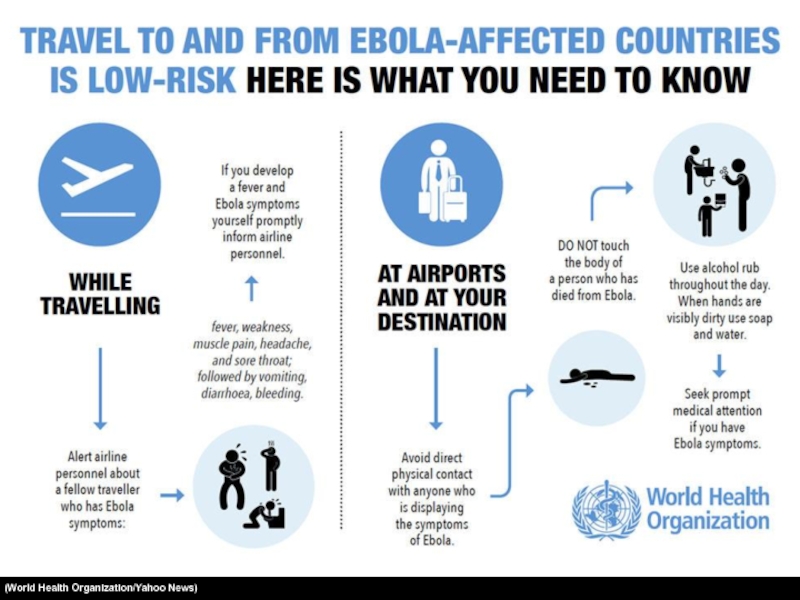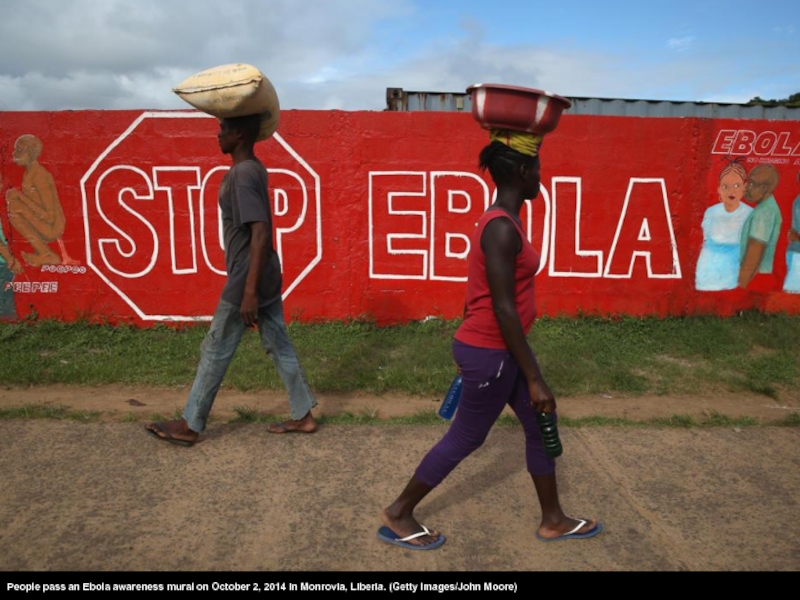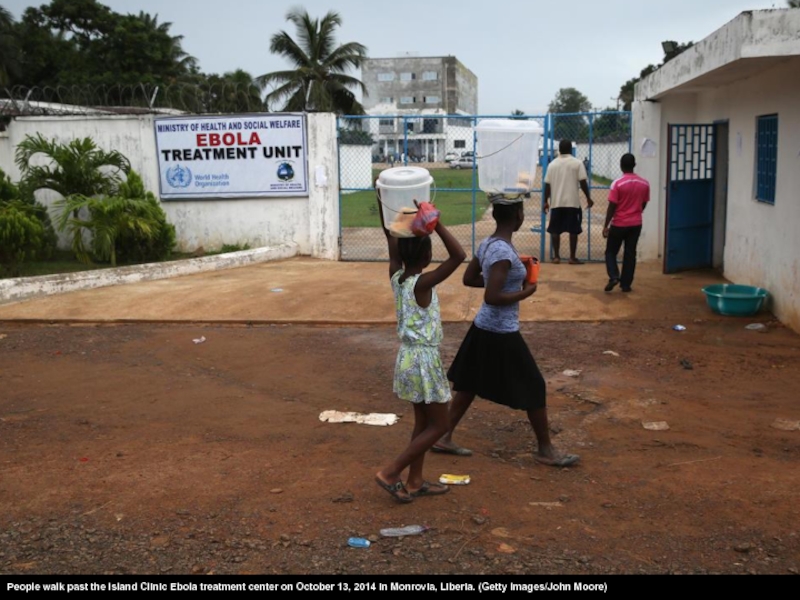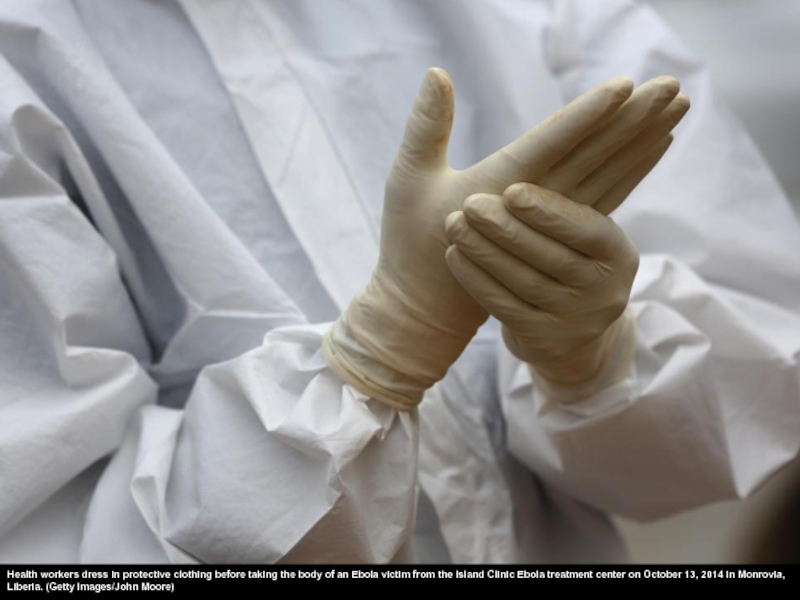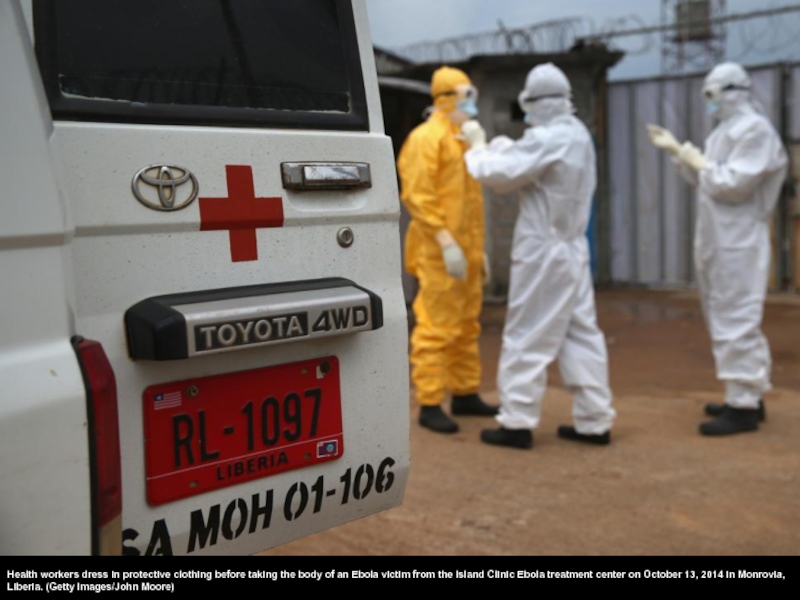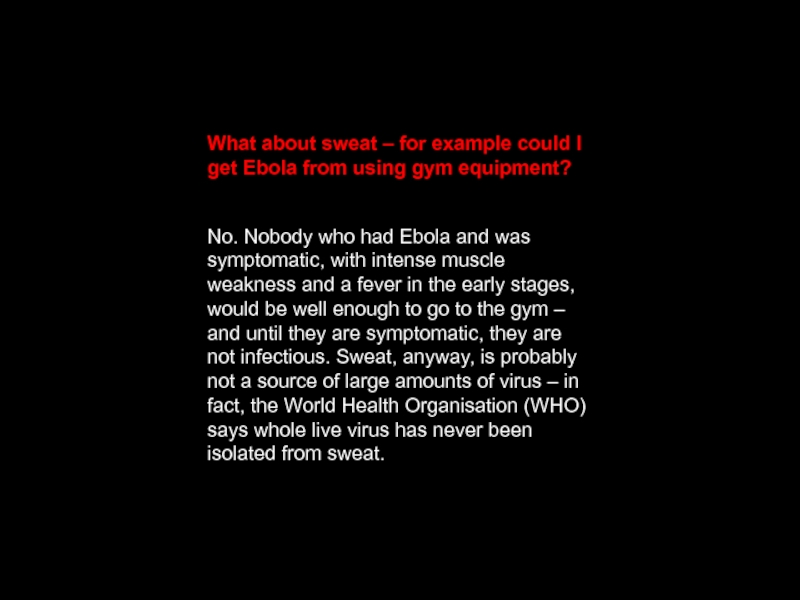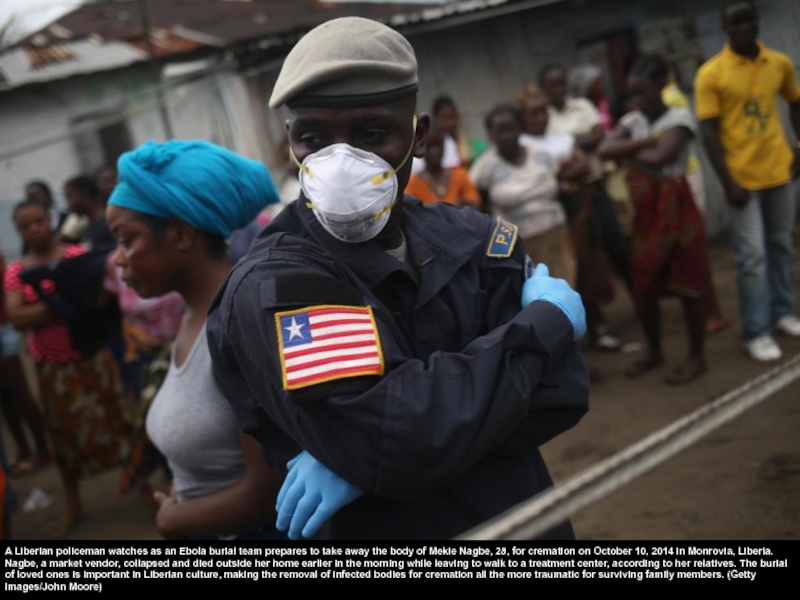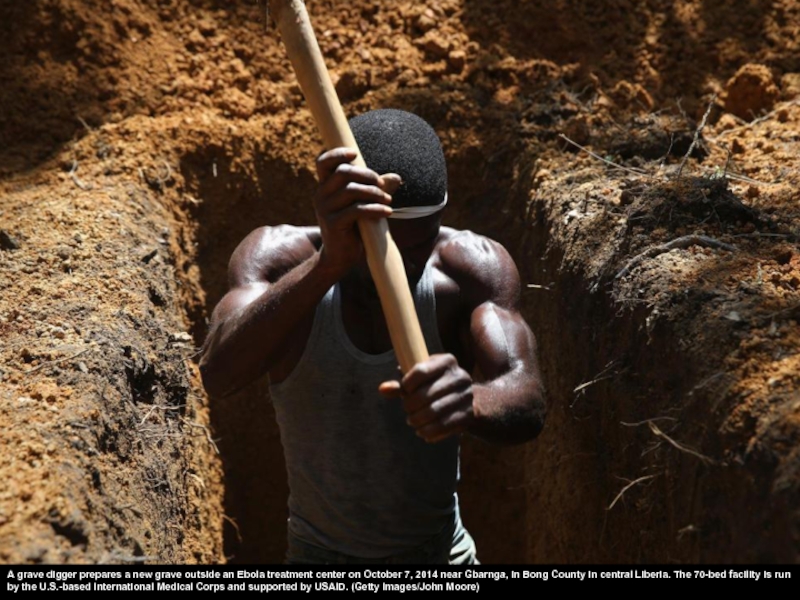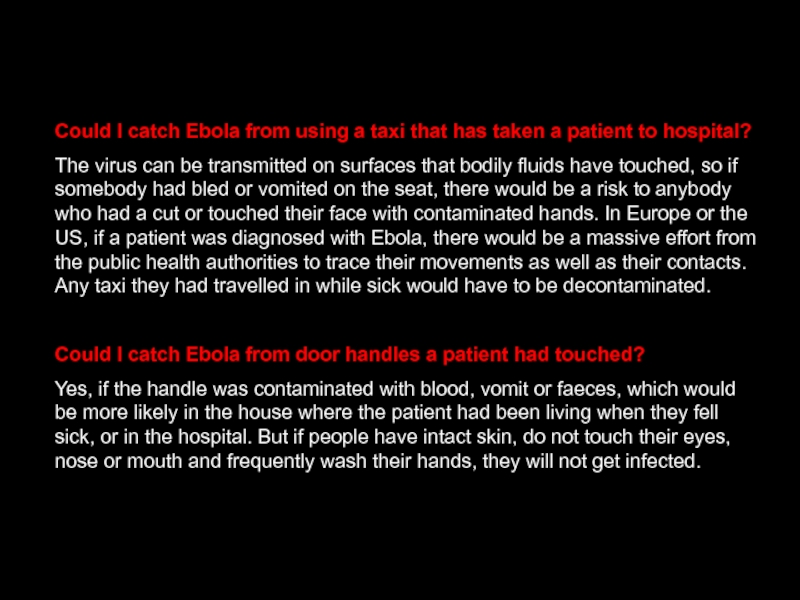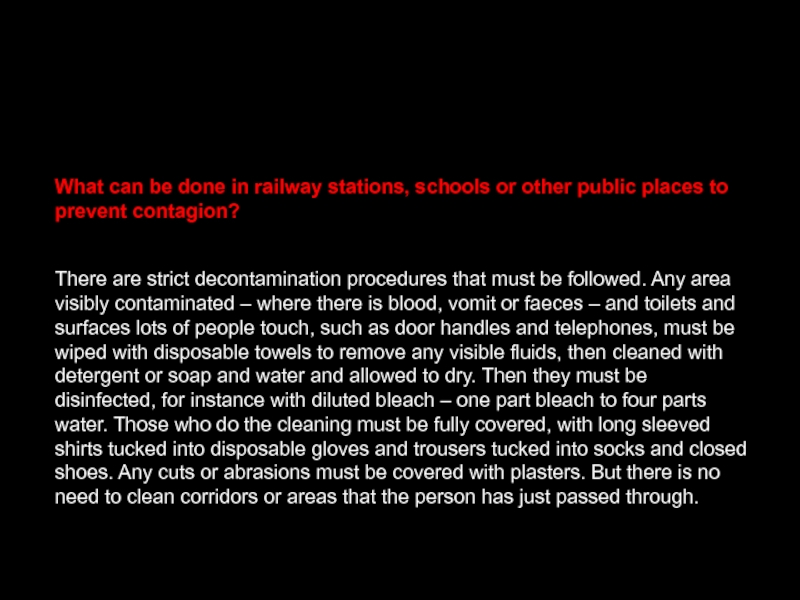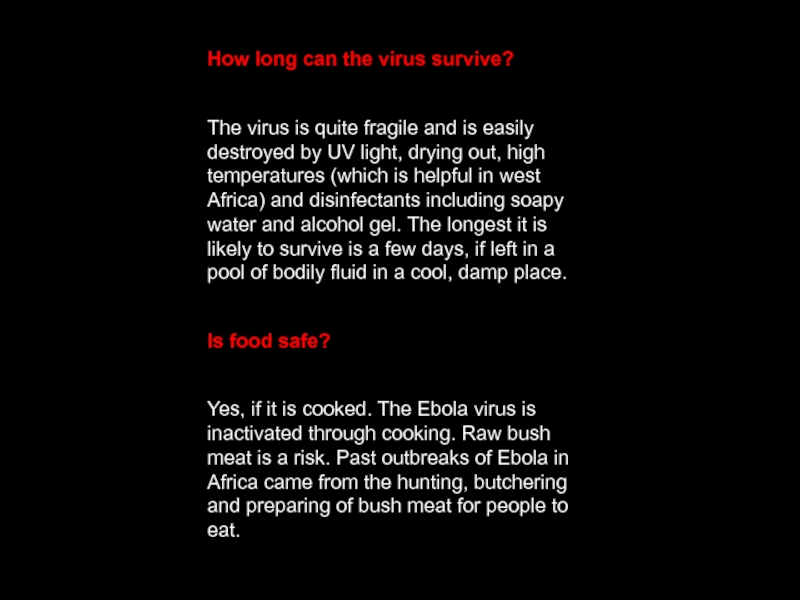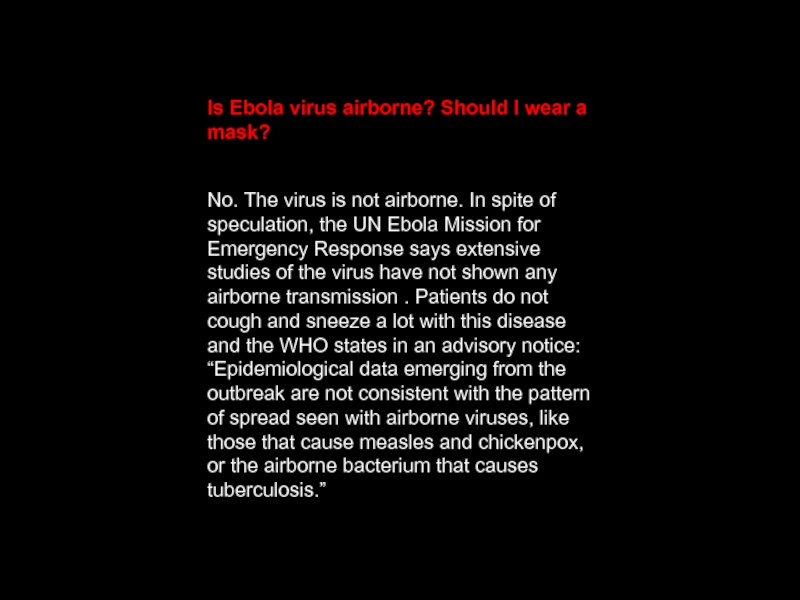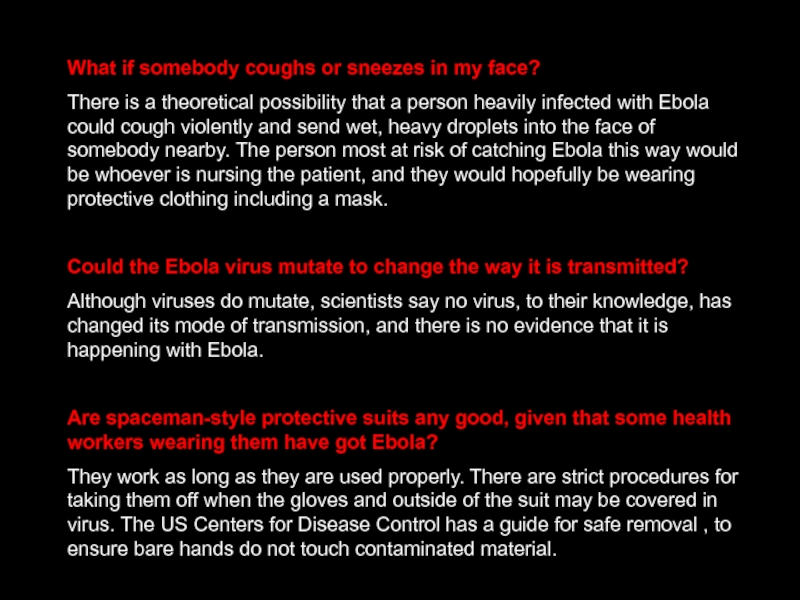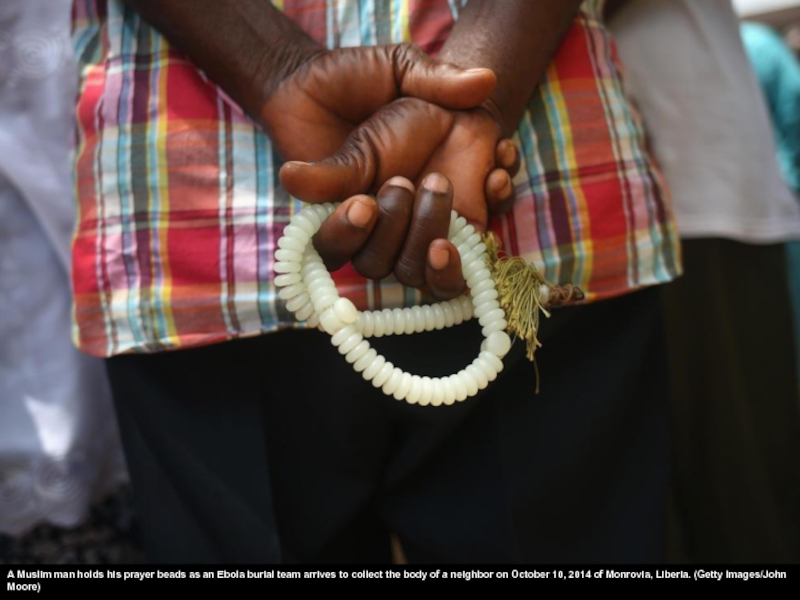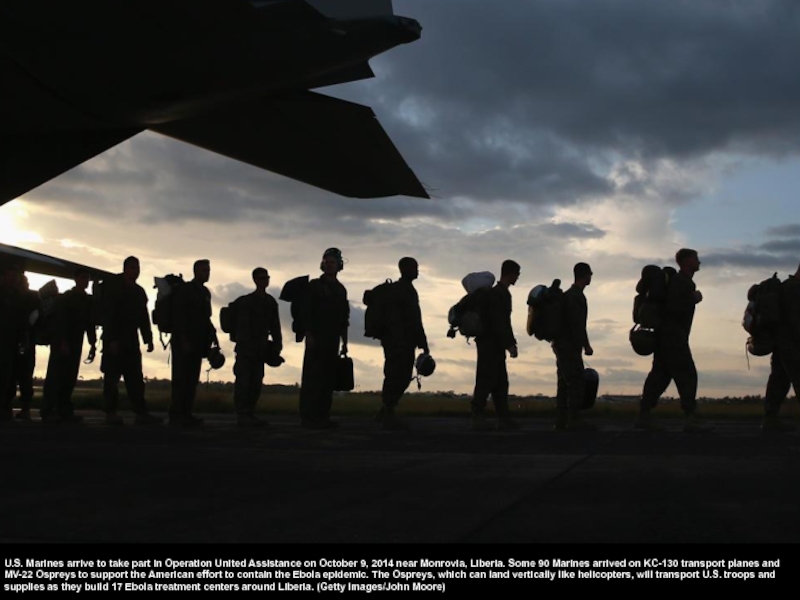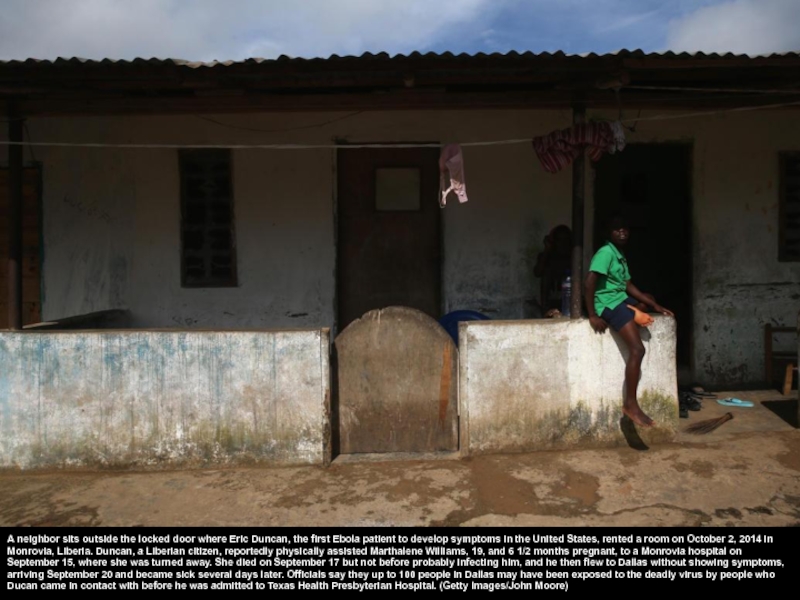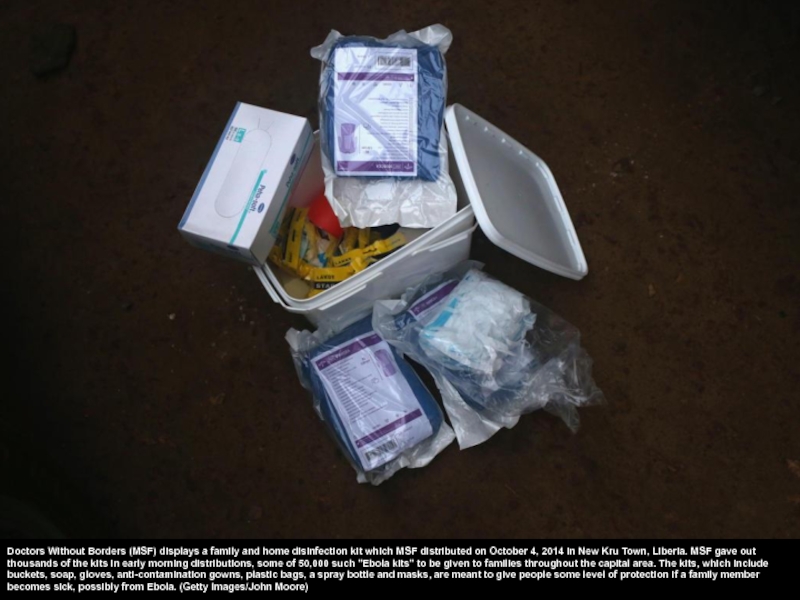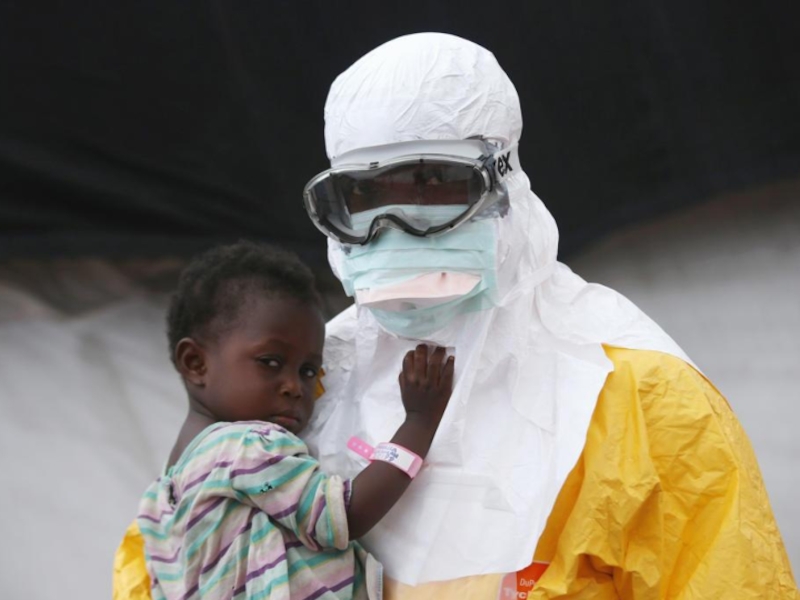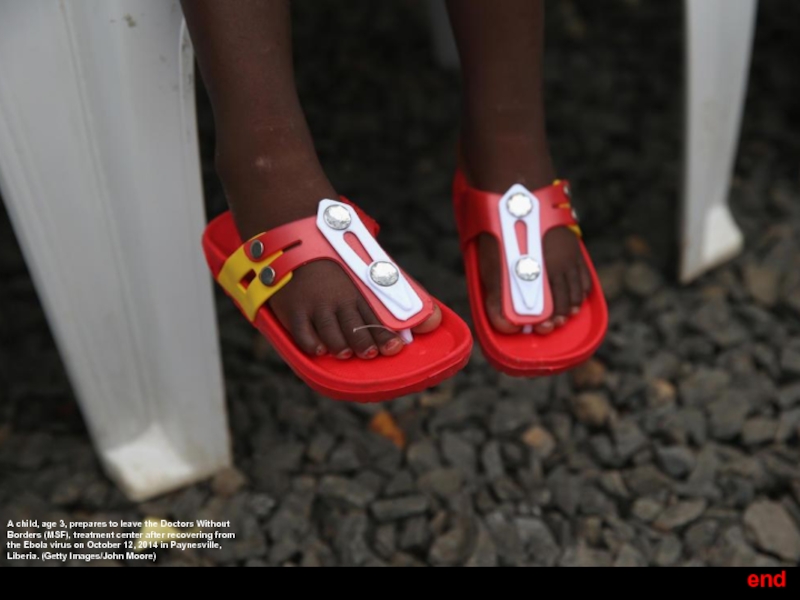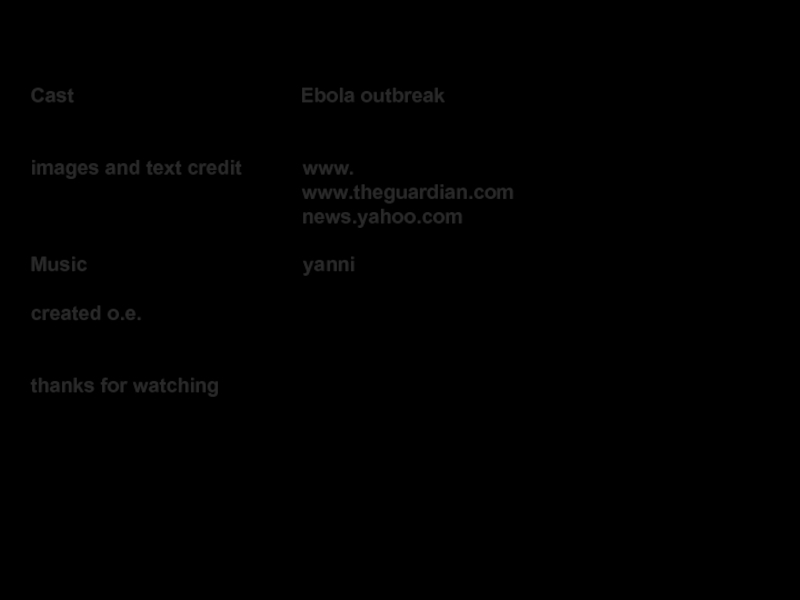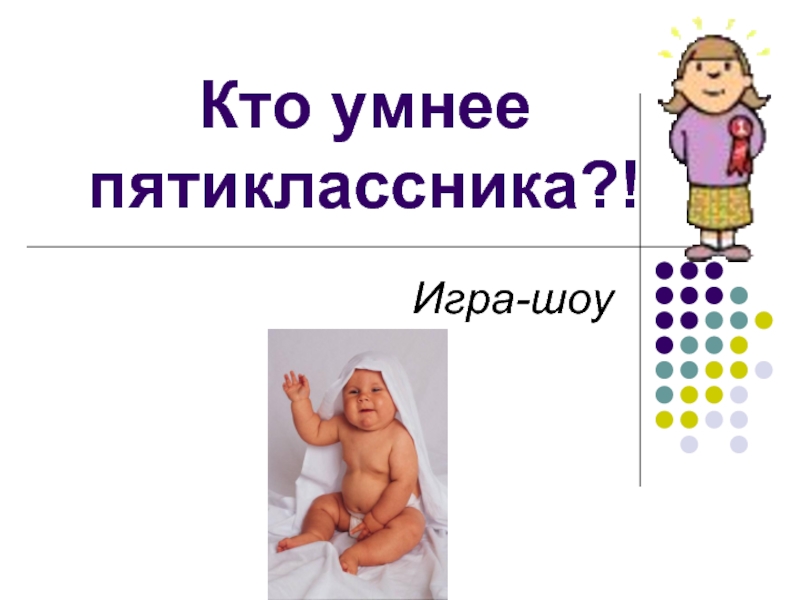from a Ministry of Health treatment center for cremation on October 2, 2014 in Monrovia, Liberia. (Getty Images/John Moore)
- Главная
- Разное
- Дизайн
- Бизнес и предпринимательство
- Аналитика
- Образование
- Развлечения
- Красота и здоровье
- Финансы
- Государство
- Путешествия
- Спорт
- Недвижимость
- Армия
- Графика
- Культурология
- Еда и кулинария
- Лингвистика
- Английский язык
- Астрономия
- Алгебра
- Биология
- География
- Детские презентации
- Информатика
- История
- Литература
- Маркетинг
- Математика
- Медицина
- Менеджмент
- Музыка
- МХК
- Немецкий язык
- ОБЖ
- Обществознание
- Окружающий мир
- Педагогика
- Русский язык
- Технология
- Физика
- Философия
- Химия
- Шаблоны, картинки для презентаций
- Экология
- Экономика
- Юриспруденция
A health worker watches as a burial team collects Ebola victims from a Ministry of Health treatment center for cremation on October 2, 2014 in Monrovia, Liberia. (Getty Images/John Moore) презентация
Содержание
- 1. A health worker watches as a burial team collects Ebola victims from a Ministry of Health treatment center for cremation on October 2, 2014 in Monrovia, Liberia. (Getty Images/John Moore)
- 2. West Africa could face up to 10,000
- 3. A member of a burial team prepares
- 4. A security guard watches as construction workers
- 5. Ebola virus facts
- 6. Ebola outbreak in west Africa, Nigeria and
- 7. Ebola virus facts Ebola virus disease
- 8. (World Health Organization/Yahoo News)
- 9. (World Health Organization/Yahoo News)
- 10. (World Health Organization/Yahoo News)
- 11. (World Health Organization/Yahoo News)
- 12. (World Health Organization/Yahoo News)
- 13. (World Health Organization/Yahoo News)
- 14. People pass an Ebola awareness mural on
- 15. WHO: Ebola death rate rises to
- 16. Liberia races to expand Ebola treatment facilities
- 17. People walk past the Island Clinic Ebola
- 18. Health workers dress in protective clothing before
- 19. Health workers dress in protective clothing before
- 20. How is Ebola spread? The Ebola
- 21. What are the symptoms? It can
- 22. What about sweat – for example could
- 23. How about saliva? WHO says saliva at
- 24. A Liberian policeman watches as an Ebola
- 25. A grave digger prepares a new grave
- 26. Could I catch Ebola from using a
- 27. What can be done in railway stations,
- 28. How long can the virus survive?
- 29. Is Ebola virus airborne? Should I wear
- 30. What if somebody coughs or sneezes in
- 31. A Muslim man holds his prayer beads
- 32. A mosquito net hangs in a one-room
- 33. U.S. Marines arrive to take part in
- 34. A health worker washes his hands in
- 35. Sanitized gloves and boots hang to dry
- 36. A neighbor sits outside the locked door
- 37. Doctors Without Borders (MSF) displays a family
- 38. A child looks up as residents of
- 39. A World Health Organization (WHO), instructor teaches
- 40. A Liberian health worker dressed in an
- 41. Maru, 3, waits outside to enter the
- 42. A Doctors Without Borders (MSF), health worker
- 44. A child, age 3, prepares to leave
- 45. Cast
Слайд 2West Africa could face up to 10,000 new Ebola cases a
week within two months, the World Health Organization warned Tuesday, adding that the death rate in the current outbreak has risen to 70 percent.
October 14, 2014
October 14, 2014
Слайд 3A member of a burial team prepares to collect Ebola victims
from a treatment center for cremation on October 2, 2014 in Monrovia, Liberia. Eight Liberian Red Cross burial teams under contract with the country's Ministry of Health collect the bodies of Ebola victims each day in the capital. (Getty Images/John Moore)
Слайд 4A security guard watches as construction workers build a new Ebola
isolation and treatment center overnight on Ocober 2, 2014 in Monrovia, Liberia. Work continues 24-hours a day on such centers, which still cannot keep up with demand as the Ebola epidemic continues to spread. (Getty Images/John Moore)
Слайд 6Ebola outbreak in west Africa, Nigeria and aboard as of Oct.
15, 2014. (World Health Organization/Yahoo News)
Слайд 7Ebola virus facts
Ebola virus disease (formerly known as Ebola haemorrhagic fever)
is a severe, often fatal illness, with a case fatality rate of up to 90%. It is one of the world’s most virulent diseases. The infection is transmitted by direct contact with the blood, body fluids and tissues of infected animals or people.
Severely ill patients require intensive supportive care. During an outbreak, those at higher risk of infection are health workers, family members and others in close contact with sick people and deceased patients. (World Health Organization)
Слайд 14People pass an Ebola awareness mural on October 2, 2014 in
Monrovia, Liberia. (Getty Images/John Moore)
Слайд 15
WHO: Ebola death rate rises to 70 percent
The death rate in
the Ebola outbreak has risen to 70 percent and there could be up to 10,000 new cases a week in two months, the World Health Organization warned Tuesday.
WHO assistant director-general Dr. Bruce Aylward gave the grim figures during a news conference in Geneva. Previously, WHO had estimated the death rate at around 50 percent.
Aylward said the 70 percent death rate was “a high mortality disease” in any circumstance and that the U.N. health agency was still focused on trying to get sick people isolated and provide treatment as early as possible.
He told reporters that if the world’s response to the Ebola crisis isn’t stepped up within 60 days, “a lot more people will die” and there will be a huge need to deal with the spiraling numbers of cases.
Tuesday, October 14, 2014 Geneva (AP)
WHO assistant director-general Dr. Bruce Aylward gave the grim figures during a news conference in Geneva. Previously, WHO had estimated the death rate at around 50 percent.
Aylward said the 70 percent death rate was “a high mortality disease” in any circumstance and that the U.N. health agency was still focused on trying to get sick people isolated and provide treatment as early as possible.
He told reporters that if the world’s response to the Ebola crisis isn’t stepped up within 60 days, “a lot more people will die” and there will be a huge need to deal with the spiraling numbers of cases.
Tuesday, October 14, 2014 Geneva (AP)
Слайд 16Liberia races to expand Ebola treatment facilities
A World Health Organization official
says there could be up to 10,000 new cases of Ebola per week within two months.
WHO assistant director-general Dr. Bruce Aylward says if the response to the Ebola crisis isn't stepped up within 60 days, "a lot more people will die" and there will be a huge need on the ground to deal with the spiraling numbers of cases. He said WHO estimated there could up to 10,000 cases per week in two months. (AP)
Photo:A doctor outside the JFK Ebola treatment center speaks to journalists on October 13, 2014 in Monrovia, Liberia. (Getty Images/John Moore)
WHO assistant director-general Dr. Bruce Aylward says if the response to the Ebola crisis isn't stepped up within 60 days, "a lot more people will die" and there will be a huge need on the ground to deal with the spiraling numbers of cases. He said WHO estimated there could up to 10,000 cases per week in two months. (AP)
Photo:A doctor outside the JFK Ebola treatment center speaks to journalists on October 13, 2014 in Monrovia, Liberia. (Getty Images/John Moore)
Слайд 17People walk past the Island Clinic Ebola treatment center on October
13, 2014 in Monrovia, Liberia. (Getty Images/John Moore)
Слайд 18Health workers dress in protective clothing before taking the body of
an Ebola victim from the Island Clinic Ebola treatment center on October 13, 2014 in Monrovia, Liberia. (Getty Images/John Moore)
Слайд 19Health workers dress in protective clothing before taking the body of
an Ebola victim from the Island Clinic Ebola treatment center on October 13, 2014 in Monrovia, Liberia. (Getty Images/John Moore)
Слайд 20How is Ebola spread?
The Ebola virus is transmitted in the bodily
fluids of people who are seriously ill, who are likely to be vomiting, bleeding or have diarrhoea. Blood, faeces and vomit are the most infectious fluids, and in late stages of the disease even tiny amounts can carry high loads of virus. But a nurse who got a patient’s blood on their hands could wash it off with soap and water without any ill-effects. He or she would become ill only if they had a cut or abrasion on their hand or touched their mouth, eyes or nose, which would allow the virus to pass into their bodily fluids.
Слайд 21What are the symptoms?
It can take two to 21 days for
symptoms to show, although usually it is five to seven days. Typically, the first signs are a fever involving a headache, joint and muscle pain, sore throat and severe muscle weakness. Many of those symptoms are similar to flu, so Ebola is not immediately obvious, though it should be suspected in anyone who has been in west Africa recently. After that come diarrhoea, vomiting, a rash and stomach pain. The kidneys and liver stop working properly. Patients may bleed internally and also from the ears, nose, eyes and mouth.
Слайд 22What about sweat – for example could I get Ebola from
using gym equipment?
No. Nobody who had Ebola and was symptomatic, with intense muscle weakness and a fever in the early stages, would be well enough to go to the gym – and until they are symptomatic, they are not infectious. Sweat, anyway, is probably not a source of large amounts of virus – in fact, the World Health Organisation (WHO) says whole live virus has never been isolated from sweat.
No. Nobody who had Ebola and was symptomatic, with intense muscle weakness and a fever in the early stages, would be well enough to go to the gym – and until they are symptomatic, they are not infectious. Sweat, anyway, is probably not a source of large amounts of virus – in fact, the World Health Organisation (WHO) says whole live virus has never been isolated from sweat.
Слайд 23How about saliva?
WHO says saliva at the most severe stage of
the disease, and also tears, may carry some risk, but the studies are inconclusive. The virus has been detected in breast milk. A 2007 study in the Journal of Infectious Diseases is probably the most informative on where the virus hides.
Can I get Ebola from a toilet seat?
Yes – faeces from somebody with Ebola are a real hazard and the virus has also been detected in urine. But there would only be a danger if a seriously sick person had used the toilet and contaminated it and that is most likely in their home or hospital. Public toilets, in general, are very unlikely to be a risk.
Can it be sexually transmitted?
Yes, and the virus lasts in the semen of people who have recovered, maybe for as long as 90 days.
Can I get Ebola from a toilet seat?
Yes – faeces from somebody with Ebola are a real hazard and the virus has also been detected in urine. But there would only be a danger if a seriously sick person had used the toilet and contaminated it and that is most likely in their home or hospital. Public toilets, in general, are very unlikely to be a risk.
Can it be sexually transmitted?
Yes, and the virus lasts in the semen of people who have recovered, maybe for as long as 90 days.
Слайд 24A Liberian policeman watches as an Ebola burial team prepares to
take away the body of Mekie Nagbe, 28, for cremation on October 10, 2014 in Monrovia, Liberia. Nagbe, a market vendor, collapsed and died outside her home earlier in the morning while leaving to walk to a treatment center, according to her relatives. The burial of loved ones is important in Liberian culture, making the removal of infected bodies for cremation all the more traumatic for surviving family members. (Getty Images/John Moore)
Слайд 25A grave digger prepares a new grave outside an Ebola treatment
center on October 7, 2014 near Gbarnga, in Bong County in central Liberia. The 70-bed facility is run by the U.S.-based International Medical Corps and supported by USAID. (Getty Images/John Moore)
Слайд 26Could I catch Ebola from using a taxi that has taken
a patient to hospital?
The virus can be transmitted on surfaces that bodily fluids have touched, so if somebody had bled or vomited on the seat, there would be a risk to anybody who had a cut or touched their face with contaminated hands. In Europe or the US, if a patient was diagnosed with Ebola, there would be a massive effort from the public health authorities to trace their movements as well as their contacts. Any taxi they had travelled in while sick would have to be decontaminated.
Could I catch Ebola from door handles a patient had touched?
Yes, if the handle was contaminated with blood, vomit or faeces, which would be more likely in the house where the patient had been living when they fell sick, or in the hospital. But if people have intact skin, do not touch their eyes, nose or mouth and frequently wash their hands, they will not get infected.
The virus can be transmitted on surfaces that bodily fluids have touched, so if somebody had bled or vomited on the seat, there would be a risk to anybody who had a cut or touched their face with contaminated hands. In Europe or the US, if a patient was diagnosed with Ebola, there would be a massive effort from the public health authorities to trace their movements as well as their contacts. Any taxi they had travelled in while sick would have to be decontaminated.
Could I catch Ebola from door handles a patient had touched?
Yes, if the handle was contaminated with blood, vomit or faeces, which would be more likely in the house where the patient had been living when they fell sick, or in the hospital. But if people have intact skin, do not touch their eyes, nose or mouth and frequently wash their hands, they will not get infected.
Слайд 27What can be done in railway stations, schools or other public
places to prevent contagion?
There are strict decontamination procedures that must be followed. Any area visibly contaminated – where there is blood, vomit or faeces – and toilets and surfaces lots of people touch, such as door handles and telephones, must be wiped with disposable towels to remove any visible fluids, then cleaned with detergent or soap and water and allowed to dry. Then they must be disinfected, for instance with diluted bleach – one part bleach to four parts water. Those who do the cleaning must be fully covered, with long sleeved shirts tucked into disposable gloves and trousers tucked into socks and closed shoes. Any cuts or abrasions must be covered with plasters. But there is no need to clean corridors or areas that the person has just passed through.
There are strict decontamination procedures that must be followed. Any area visibly contaminated – where there is blood, vomit or faeces – and toilets and surfaces lots of people touch, such as door handles and telephones, must be wiped with disposable towels to remove any visible fluids, then cleaned with detergent or soap and water and allowed to dry. Then they must be disinfected, for instance with diluted bleach – one part bleach to four parts water. Those who do the cleaning must be fully covered, with long sleeved shirts tucked into disposable gloves and trousers tucked into socks and closed shoes. Any cuts or abrasions must be covered with plasters. But there is no need to clean corridors or areas that the person has just passed through.
Слайд 28How long can the virus survive?
The virus is quite fragile and
is easily destroyed by UV light, drying out, high temperatures (which is helpful in west Africa) and disinfectants including soapy water and alcohol gel. The longest it is likely to survive is a few days, if left in a pool of bodily fluid in a cool, damp place.
Is food safe?
Yes, if it is cooked. The Ebola virus is inactivated through cooking. Raw bush meat is a risk. Past outbreaks of Ebola in Africa came from the hunting, butchering and preparing of bush meat for people to eat.
Is food safe?
Yes, if it is cooked. The Ebola virus is inactivated through cooking. Raw bush meat is a risk. Past outbreaks of Ebola in Africa came from the hunting, butchering and preparing of bush meat for people to eat.
Слайд 29Is Ebola virus airborne? Should I wear a mask?
No. The virus
is not airborne. In spite of speculation, the UN Ebola Mission for Emergency Response says extensive studies of the virus have not shown any airborne transmission . Patients do not cough and sneeze a lot with this disease and the WHO states in an advisory notice: “Epidemiological data emerging from the outbreak are not consistent with the pattern of spread seen with airborne viruses, like those that cause measles and chickenpox, or the airborne bacterium that causes tuberculosis.”
Слайд 30What if somebody coughs or sneezes in my face?
There is a
theoretical possibility that a person heavily infected with Ebola could cough violently and send wet, heavy droplets into the face of somebody nearby. The person most at risk of catching Ebola this way would be whoever is nursing the patient, and they would hopefully be wearing protective clothing including a mask.
Could the Ebola virus mutate to change the way it is transmitted?
Although viruses do mutate, scientists say no virus, to their knowledge, has changed its mode of transmission, and there is no evidence that it is happening with Ebola.
Are spaceman-style protective suits any good, given that some health workers wearing them have got Ebola?
They work as long as they are used properly. There are strict procedures for taking them off when the gloves and outside of the suit may be covered in virus. The US Centers for Disease Control has a guide for safe removal , to ensure bare hands do not touch contaminated material.
Could the Ebola virus mutate to change the way it is transmitted?
Although viruses do mutate, scientists say no virus, to their knowledge, has changed its mode of transmission, and there is no evidence that it is happening with Ebola.
Are spaceman-style protective suits any good, given that some health workers wearing them have got Ebola?
They work as long as they are used properly. There are strict procedures for taking them off when the gloves and outside of the suit may be covered in virus. The US Centers for Disease Control has a guide for safe removal , to ensure bare hands do not touch contaminated material.
Слайд 31A Muslim man holds his prayer beads as an Ebola burial
team arrives to collect the body of a neighbor on October 10, 2014 of Monrovia, Liberia. (Getty Images/John Moore)
Слайд 32A mosquito net hangs in a one-room apartment where an Ebola
burial team had just collected the body of a four-year-old girl on October 10, 2014 in Monrovia, Liberia. (Getty Images/John Moore)
Слайд 33U.S. Marines arrive to take part in Operation United Assistance on
October 9, 2014 near Monrovia, Liberia. Some 90 Marines arrived on KC-130 transport planes and MV-22 Ospreys to support the American effort to contain the Ebola epidemic. The Ospreys, which can land vertically like helicopters, will transport U.S. troops and supplies as they build 17 Ebola treatment centers around Liberia. (Getty Images/John Moore)
Слайд 34A health worker washes his hands in chlorinated water while removing
protective clothing after an hourlong shift in the high risk area of the Doctors Without Borders (MSF), treatment center on October 5, 2014 in Paynesville, Liberia. (Getty Images/John Moore)
Слайд 35Sanitized gloves and boots hang to dry as a burial team
collects Ebola victims from a Ministry of Health treatment center for cremation on October 2, 2014 in Monrovia, Liberia. (Getty Images/John Moore)
Слайд 36A neighbor sits outside the locked door where Eric Duncan, the
first Ebola patient to develop symptoms in the United States, rented a room on October 2, 2014 in Monrovia, Liberia. Duncan, a Liberian citizen, reportedly physically assisted Marthalene Williams, 19, and 6 1/2 months pregnant, to a Monrovia hospital on September 15, where she was turned away. She died on September 17 but not before probably infecting him, and he then flew to Dallas without showing symptoms, arriving September 20 and became sick several days later. Officials say they up to 100 people in Dallas may have been exposed to the deadly virus by people who Ducan came in contact with before he was admitted to Texas Health Presbyterian Hospital. (Getty Images/John Moore)
Слайд 37Doctors Without Borders (MSF) displays a family and home disinfection kit
which MSF distributed on October 4, 2014 in New Kru Town, Liberia. MSF gave out thousands of the kits in early morning distributions, some of 50,000 such "Ebola kits" to be given to families throughout the capital area. The kits, which include buckets, soap, gloves, anti-contamination gowns, plastic bags, a spray bottle and masks, are meant to give people some level of protection if a family member becomes sick, possibly from Ebola. (Getty Images/John Moore)
Слайд 38A child looks up as residents of an Ebola affected township
wait before dawn to receive family and home disinfection kits distributed by Doctors Without Borders (MSF), on October 4, 2014 in New Kru Town, Liberia. (Getty Images/John Moore)
Слайд 39A World Health Organization (WHO), instructor teaches new health workers during
a training session on October 3, 2014 in Monrovia, Liberia. The WHO is training some 400 new health workers in two-week courses for the Liberian Ministry of Health. Many of the new health workers will be stationed in some of th 17 Ebola treatment units to be built by the U.S. military. (Getty Images/John Moore)
Слайд 40A Liberian health worker dressed in an anti-contamination suit speaks with
a boy at a center for suspected Ebola patients, formerly the maternity ward at Redemption Hospital on October 3, 2014 in Monrovia, Liberia. (Getty Images/John Moore)
Слайд 41Maru, 3, waits outside to enter the ELWA 3 Doctors Without
Borders Ebola treatment center on October 3, 2014 in Paynesville, Liberia. Filled to its current 250-bed capacity, the center can only take in as many new Ebola patients as the number of people who die overnight. (Getty Images/John Moore)
Слайд 42A Doctors Without Borders (MSF), health worker in protective clothing holds
a child suspected of having Ebola in the MSF treatment center on October 5, 2014 in Paynesville, Liberia. (Getty Images/John Moore)
Слайд 44A child, age 3, prepares to leave the Doctors Without Borders
(MSF), treatment center after recovering from the Ebola virus on October 12, 2014 in Paynesville, Liberia. (Getty Images/John Moore)
end
Слайд 45Cast
Ebola outbreak
images and text credit www.
www.theguardian.com
news.yahoo.com
Music yanni
created o.e.
thanks for watching
images and text credit www.
www.theguardian.com
news.yahoo.com
Music yanni
created o.e.
thanks for watching

